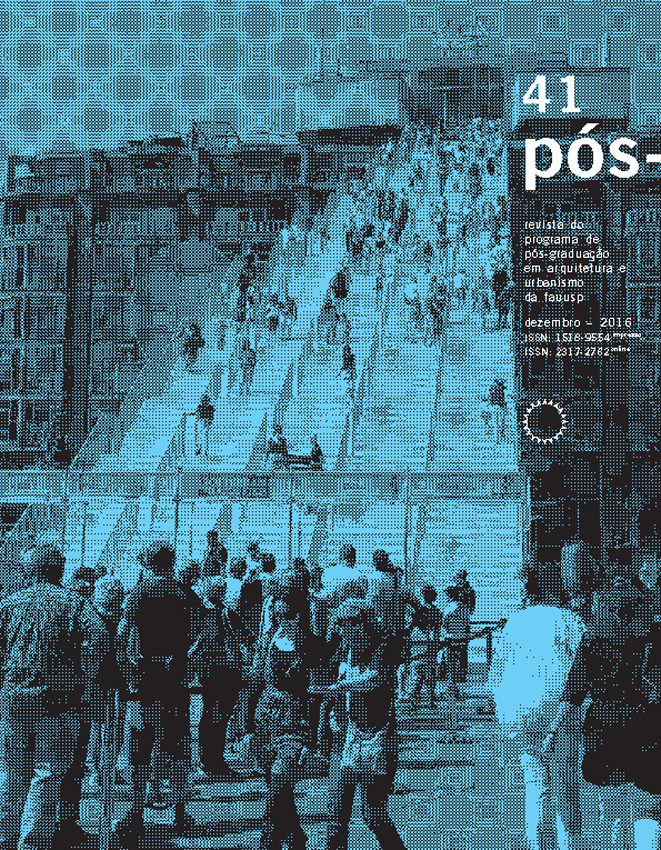Surface urban heat island and buildings energy: visualization of urban climatic flows
DOI:
https://doi.org/10.11606/issn.2317-2762.v23i41p122-139Keywords:
Surface Urban Heat Island. MODIS. Urban morphology. Remote sensing. GIS.Abstract
The surface urban heat island (SUHI) effect can be defined as the relative warmth of urban surfaces compared with its surroundings due to the difference in their respective cooling rates. Classic studies have demonstrated that urban warming is a regional and occasional phenomenon whose occurrence depends on weather conditions and characteristics of the urban fabric. Satellite imagery and GIS are combined in this paper to unveil patterns in thermal variations across cities and relate air temperature to density or land cover. Six European regions were selected: Madrid (40ºN, 3ºE), Cologne (50ºN, 6ºE), Barcelona (41ºN,2ºE) London (51ºN,0.5ºW), Brussels(50ºN,4ºE) and Berlin(52ºN,13ºE). Images with information on surface temperature were obtained from Modis Satellite database. Over 120 files were scrutinized to select 6 winter and summer days and nights. From these, six summer nights are presented as they offer the clearest land surface temperature distribution. The spatial correlation between air temperature, density and land cover was analysed in GIS and plotted as citywide cross sections. The strongest correspondence was found between density and land cover. Finally, the influence of UHI in the energy demand of domestic buildings in London and Barcelona was investigated. This analysis showed the greater relative impact of this phenomenon in warmer regions.
Downloads
References
ARNFIELD, A.J. Two decades of urban climate research: a review of turbulence exchanges of energy and water, and the urban heat island. International Journal of Climatology, 23 1-26, 2003.
BARRY, R.G. and CHORLEY, R.J. (8th ed.) Atmosphere, Weather and Climate. Routledge, 2003.
CABRITA, A.L. and XXX-XXX (MASKED FOR BLIND REVIEW), J. BREEAM Communities in Spain. In BREBBIA, C.A. (2011) The Sustinable World. WIT Press, Southampton, 2011.
CHANDLER, T.J. The Climate of London. Hutchinson. London, 1965.
CHAO, R. NG, E.Y. KATZSCHNER, L. Urban climatic map studies: a review. International Journal of Climatology (31) 15: 2213-2233, 2010.
DOUGLAS, I. The Urban Environment. Arnold.London, 1983.
EARTH EXPLORER (2013). Disponível em:: http://earthexplorer.usgs.gov/. Acesso em: 6 maio 2013.
EDWARDS, B. (3rd ed.) Rough Guide to Sustainability. A Design Primer. RIBA Publishing, 2010.
ELIASSON, I. The use of climate knowledge in urban planning. Landscape and Urban Planning 48:31-44, 2000.
EUROPEAN ENVIRONMENT AGENCY (2013a) Population density disaggregated with Corine land cover 2000. Disponível em: www.eea.europa.eu/data-and-maps/data/population-density-disaggregated-with-corine-land-cover-2000-2. Acesso em: 6 maio 2013.
EUROPEAN ENVIRONMENT AGENCY (2013b) Urban Atlas. Disponível em: www.eea.europa.eu/data-and-maps/data/urban-atlas. 6 maio 2013.
FOLEY, J. A. et al. Global Consequenes of Land Use. In Science (309):570-574, 2005.
GRIMMOND, S. London's Urban Climate: Historical and Contemporary Perspectives. City Weathers: Meteorology and Urban Design 1950-2010. Manchester Architecture Research Centre. 23-24 June 2011. University of Manchester, 2011.
HARTMANN, F.L. et al. Observations: Atmosphere and Surface. In: Climate Change 2013: The Physical Science Basis. Contribution of Working Group I to the Fifth Assessment Report of the Intergovernmental Panel on Climate Change. Cambridge University Press, Cambridge, UK and New York, USA, 2013.
HOUGH, M. Cities and Natural Processes: A Basis for Sustainability. New York. Routledge, 2004.
ICHINOSE, T. Shimodozono, K. & HANAKI, K. (1999) Impact of anthropogenic heat or urban climate in Tokyo. Atmospheric Environment n.33 pp.3897-3909. Pergamon
LANDSBERG,H.E. The Urban Climate. New York Academic Press, 1981.
LITTLEFAIR, P.J. SANTAMOURIS, M. ALVAREZ, S. DUPAGNE, A. HALL, D. TELLER, J. CORONEL, J.F. PAPANIKOLAU, N. Environmental Site Layout Planning: Solar Access, Microclimate and Passive Cooling in Urban Areas. Construction Research Communications, 2000.
LYNCH, K. Good City Form. The MIT Press, 1981.
METEONORM. Global Meteorological Database, 2013.
OKE, T.R. (2011). Urban Heat islands. In Douglas, I. Goode, D. Houck, M. & Wang, R. The Routledge Handbook of Urban Ecology. Routledge Handbooks, 2011.
OKE, T.R. Boundary Layer Climates. Methuen & Co., London. 1987.
OKE, T.R. Towards a prescription for the greater use of climatic principles in settlement planning. Energy and Buildings (7) 1:1-10, 1984.
ROAF, S. Crichton, D. and NICOL, F. eds. Adapting Buildings and Cities For Climate Change. A 21st Century Survival Guide. Architectural Press. London.2009.
RODRÍGUEZ-ALVAREZ, J. Planning Cities for the Post-Carbon Age. A Metabolic Analysis of the Urban Form. PhD Thesis. University of A Coruña, 2014.
SATELLITE AQUA, (2013). Disponível em: www.aqua.nasa.gov. Acesso em: 6 maio 2013.
SCHILLER, S. and EVANS, J.M. Bridging the gap between climate and design at the urban and building scale: research and application. Energy and Buildings 15-16: 51-55, 1991.
SPIRN, A. W. The Granite Garden. Urban Nature and Human Design. Harper Collins Publishers, 1984.
STOCKER, T.F. et al. Technical Summary. In : Climate Change 2013. The Physical Science Basis. Contribution of Working Group I to the Fifth Assessment Report of the Intergovernmental Panel on Climate Change. Cambridge University Press, Cambridge, UK and New York, USA, 2013.
VOOGT, J.A. and OKE, T.R. Thermal remote sensing of urban climates. Remote Sensing of the Environment, 86: 370-384, 2003.
WATSON, R.T. Zinyowera, M.C: and Moss, R.HThe Regional Impacts of Climate Change: An Assessment of Vulnerability. Cambridge University Press, UK, 1997.
Downloads
Published
Issue
Section
License

This work is licensed under a Creative Commons Attribution 4.0 International License.
DIADORIM - Diretório de Políticas Editoriais












